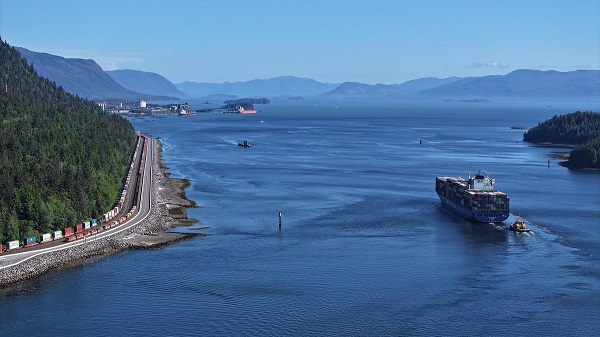Economy
Feds outline $83B in clean economy tax credits in bid to compete with U.S. incentive

Prime Minister Justin Trudeau and Deputy Prime Minister and Minister of Finance Chrystia Freeland arrive to deliver the federal budget in the House of Commons on Parliament Hill in Ottawa, Tuesday, March 28, 2023. THE CANADIAN PRESS/Justin Tang
Serious money is heading for Canadian industries looking to reduce emissions after the federal government unveiled its answer to the U.S. Inflation Reduction Act.
The spending commitments announced in Tuesday’s federal budget include tax credits for investments in clean electricity, clean-tech manufacturing, and hydrogen that together are expected to cost some $55 billion through to the 2034-35 fiscal year.
Total tax incentives amount to almost $83 billion over that timeframe when the carbon capture and storage and clean-tech investments credits announced last year are factored in, both of which saw minor boosts this round.
The government says the funding is necessary to boost clean economy spending from some $15 billion a year to the $100 billion a year needed. The spending is also needed to not fall behind as other countries roll out subsidies, most notably with the US$369 billion contained in the landmark U.S. legislation passed last year.
“In what is the most significant economic transformation since the Industrial Revolution, our friends and partners around the world, chief among them the United States, are investing heavily to build clean economies,” said Deputy Prime Minister Chrystia Freeland as she introduced the budget.
Tax credits are the backbone of the effort because they are stable and efficient way to roll out government support, while leaving decision-making with the expertise of the private sector, said a senior government official in the budget lockup.
Clean electricity is the biggest focus of the credits, costing $6.3 billion over the first four years starting in 2024, and $25.7 billion through to the 2034-35 year. Notably, provincial utilities and Indigenous-owned corporations will be eligible for the credits.
The spending is meant to help spur both more generation, as well as a better-connected east-west grid to meet the expected doubling of electricity demand by 2050.
The clean electricity package is where the government has likely done enough to meet its goals, said Michael Bernstein, executive director of Clean Prosperity.
Other funding areas however, including the $11.1 billion in credits for manufacturing and $12.4 billion for carbon capture through to 2034, likely aren’t enough to close the gap with what the U.S. is offering, he said.
“It really is one of those situations where your competitor has stepped up and said we are going to be providing an almost unthinkable amount of money.”
Canada has opted for construction-focused project support, while the U.S. IRA covers operational costs with payments based on production volumes. It’s like Canada is offering a single large cup of soda, whereas the U.S. is offering endless kiddy-cup sized refills, meaning Canada needs to offer a pretty big cup to compete, said Bernstein.
Since it’s not covering operations, Canada needs to move quickly on offering the carbon pricing backstop that it’s promised to develop in the budget, he said.
The so-called contracts for difference would provide certainty to industry on future carbon pricing and credits, but so far they’re still in consultation, as are several other key policies.
“What surprised me was how many things are still left to be determined,” said Rachel Samson, vice-president of research at the Institute for Research on Public Policy.
Along with the contacts for difference, she noted that details are scarce about how the $15 billion Canada Growth Fund will be spent.
The government announced in the budget that the fund will be administered independently by the Public Sector Pension Investment Board, with money starting to flow in the first half of the year, but didn’t provide guidance on priority areas.
Samson said it was good the government isn’t trying to direct the money itself, but worried that pension fund managers are too cautious to put the money in the bold projects needed.
“We need projects that are more on the cutting-edge, that are riskier.”
The government also pushed down the road any commitments on biofuels such as sustainable jet fuels, which surprised Samson as Canada is currently exporting the raw wood pellet feedstock and knows companies have projects ready to go.
The budget was also notable for what wasn’t in it for the oil and gas industry. While it did tweak last year’s carbon capture incentives, it didn’t go as far as some were pushing for, while the emissions cut-off for hydrogen production will likely exclude most carbon-capture based hydrogen projects.
“Oil and gas did not get a lot of what I think it wanted in this,” said Samson.
The lack of funding comes as climate advocacy groups have pushed against support for both programs as wasteful projects that don’t achieve the emission cuts needed in the near term, while also pushing against support for an industry that has reported record profits.
The government has also framed the budget as one of fiscal restraint that it hopes will allow private capital to do much of the heavy lifting to keep Canada in the running.
“Canada must either meet this historic moment, this remarkable opportunity before us, or we will be left behind as the world’s democracies build the clean economy of the 21st century,” said Freeland.
This report by The Canadian Press was first published March 28, 2023.
Alberta
Pierre Poilievre – Per Capita, Hardisty, Alberta Is the Most Important Little Town In Canada

From Pierre Poilievre
Business
Why it’s time to repeal the oil tanker ban on B.C.’s north coast

The Port of Prince Rupert on the north coast of British Columbia. Photo courtesy Prince Rupert Port Authority
From the Canadian Energy Centre
By Will Gibson
Moratorium does little to improve marine safety while sending the wrong message to energy investors
In 2019, Martha Hall Findlay, then-CEO of the Canada West Foundation, penned a strongly worded op-ed in the Globe and Mail calling the federal ban of oil tankers on B.C.’s northern coast “un-Canadian.”
Six years later, her opinion hasn’t changed.
“It was bad legislation and the government should get rid of it,” said Hall Findlay, now director of the University of Calgary’s School of Public Policy.
The moratorium, known as Bill C-48, banned vessels carrying more than 12,500 tonnes of oil from accessing northern B.C. ports.
Targeting products from one sector in one area does little to achieve the goal of overall improved marine transport safety, she said.
“There are risks associated with any kind of transportation with any goods, and not all of them are with oil tankers. All that singling out one part of one coast did was prevent more oil and gas from being produced that could be shipped off that coast,” she said.
Hall Findlay is a former Liberal MP who served as Suncor Energy’s chief sustainability officer before taking on her role at the University of Calgary.
She sees an opportunity to remove the tanker moratorium in light of changing attitudes about resource development across Canada and a new federal government that has publicly committed to delivering nation-building energy projects.
“There’s a greater recognition in large portions of the public across the country, not just Alberta and Saskatchewan, that Canada is too dependent on the United States as the only customer for our energy products,” she said.
“There are better alternatives to C-48, such as setting aside what are called Particularly Sensitive Sea Areas, which have been established in areas such as the Great Barrier Reef and the Galapagos Islands.”
The Business Council of British Columbia, which represents more than 200 companies, post-secondary institutions and industry associations, echoes Hall Findlay’s call for the tanker ban to be repealed.
“Comparable shipments face no such restrictions on the East Coast,” said Denise Mullen, the council’s director of environment, sustainability and Indigenous relations.
“This unfair treatment reinforces Canada’s over-reliance on the U.S. market, where Canadian oil is sold at a discount, by restricting access to Asia-Pacific markets.
“This results in billions in lost government revenues and reduced private investment at a time when our economy can least afford it.”
The ban on tanker traffic specifically in northern B.C. doesn’t make sense given Canada already has strong marine safety regulations in place, Mullen said.
Notably, completion of the Trans Mountain Pipeline expansion in 2024 also doubled marine spill response capacity on Canada’s West Coast. A $170 million investment added new equipment, personnel and response bases in the Salish Sea.
“The [C-48] moratorium adds little real protection while sending a damaging message to global investors,” she said.
“This undermines the confidence needed for long-term investment in critical trade-enabling infrastructure.”
Indigenous Resource Network executive director John Desjarlais senses there’s an openness to revisiting the issue for Indigenous communities.
“Sentiment has changed and evolved in the past six years,” he said.
“There are still concerns and trust that needs to be built. But there’s also a recognition that in addition to environmental impacts, [there are] consequences of not doing it in terms of an economic impact as well as the cascading socio-economic impacts.”
The ban effectively killed the proposed $16-billion Eagle Spirit project, an Indigenous-led pipeline that would have shipped oil from northern Alberta to a tidewater export terminal at Prince Rupert, B.C.
“When you have Indigenous participants who want to advance these projects, the moratorium needs to be revisited,” Desjarlais said.
He notes that in the six years since the tanker ban went into effect, there are growing partnerships between B.C. First Nations and the energy industry, including the Haisla Nation’s Cedar LNG project and the Nisga’a Nation’s Ksi Lisims LNG project.
This has deepened the trust that projects can mitigate risks while providing economic reconciliation and benefits to communities, Dejarlais said.
“Industry has come leaps and bounds in terms of working with First Nations,” he said.
“They are treating the rights of the communities they work with appropriately in terms of project risk and returns.”
Hall Findlay is cautiously optimistic that the tanker ban will be replaced by more appropriate legislation.
“I’m hoping that we see the revival of a federal government that brings pragmatism to governing the country,” she said.
“Repealing C-48 would be a sign of that happening.”
-

 Crime2 days ago
Crime2 days agoNational Health Care Fraud Takedown Results in 324 Defendants Charged in Connection with Over $14.6 Billion in Alleged Fraud
-

 Health2 days ago
Health2 days agoRFK Jr. Unloads Disturbing Vaccine Secrets on Tucker—And Surprises Everyone on Trump
-

 Business1 day ago
Business1 day agoElon Musk slams Trump’s ‘Big Beautiful Bill,’ calls for new political party
-

 Business13 hours ago
Business13 hours agoLatest shakedown attempt by Canada Post underscores need for privatization
-

 Business13 hours ago
Business13 hours agoWhy it’s time to repeal the oil tanker ban on B.C.’s north coast
-

 Censorship Industrial Complex1 day ago
Censorship Industrial Complex1 day agoGlobal media alliance colluded with foreign nations to crush free speech in America: House report
-

 International20 hours ago
International20 hours agoCBS settles with Trump over doctored 60 Minutes Harris interview
-

 Energy13 hours ago
Energy13 hours agoIf Canada Wants to be the World’s Energy Partner, We Need to Act Like It






